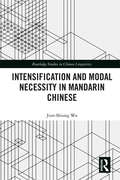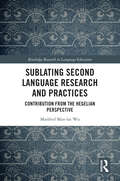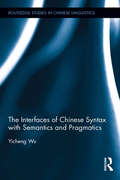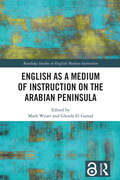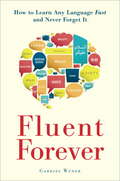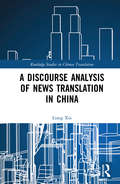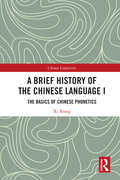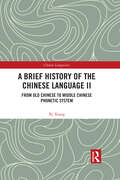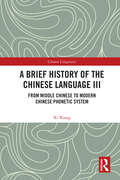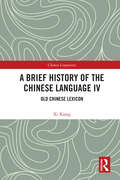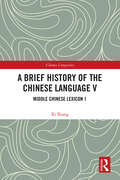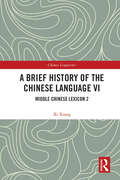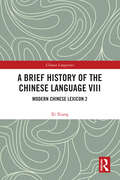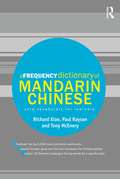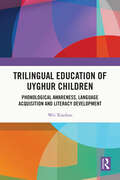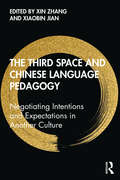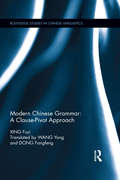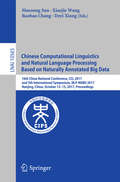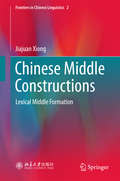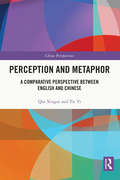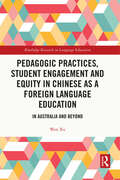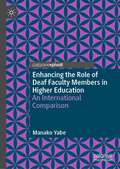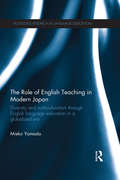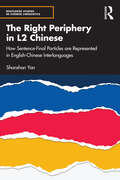- Table View
- List View
Intensification and Modal Necessity in Mandarin Chinese (Routledge Studies in Chinese Linguistics)
by Jiun-Shiung WuThis book addresses intensification and modal necessity in Mandarin Chinese. Intensification is used in this book to describe the speaker’s emphasis on a proposition, because, by emphasizing on a proposition, the speaker intensifies the degree of his/her confidence and affirmativeness toward the truth of a proposition, cf. the distinction between ‘weaker’ and ‘stronger’. Modal necessity discussed in this book refers either to the speaker’s certainty regarding the truth of an inference, judgment or stipulation, that is, epistemic necessity or to the speaker’s certainty concerning the obligatoriness of a proposition, based on rules or regulations, i.e., deontic necessity. This book examines a series of lexical items in Mandarin Chinese that express either intensification or modal necessity, provides a unified semantics and also presents how these lexical items are semantically distinct. Intensification and Modal Necessity in Mandarin Chinese is aimed at instructors, researchers and post-graduate students of Chinese Linguistics.
Sublating Second Language Research and Practices: Contribution from the Hegelian Perspective (Routledge Research in Language Education)
by Manfred Man-fat WuWu’s book provides an innovative perspective on, and recommendations for, the major aspects of second language (L2) teaching from a Hegelian anthro-philosophical perspective. Language is social in nature and is related to the larger social milieu. Hegelian philosophy of language complements existing research and theories on L2 learning by not only equipping them with a systematic framework but also broadening their scope. In Hegelian philosophy, language not only has its individual and interpersonal dimensions but is also related to the community, society, and morality. The Hegelian perspective also suggests a number of functions of L2 which have either been neglected or rejected by L2 researchers. This book highlights these neglected elements such as intersubjectivity, mutual recognition, universalization and objectivization of inner subjectivity of individuals, as well as moral enhancement. These concepts generate insights on the teaching and learning of L2. Wu’s volume also covers how the Hegelian anthro-philosophical perspective can help to re-interpret research results on L2 learner characteristics that are related to L2 learning to date such as L2 identity and autonomy. The book offers an alternative research paradigm, teaching philosophy, pedagogical implications, and suggestions for scholars, practitioners, and students in the professional field of L2 teaching.
The Interfaces of Chinese Syntax with Semantics and Pragmatics (Routledge Studies in Chinese Linguistics)
by Yicheng WuThe Interfaces of Chinese Syntax with Semantics and Pragmatics provides an in-depth exploration of a variety of interface phenomena in Chinese, a non-inflectional language, where to a large extent word order constrains its interpretation and defines its grammatical functions. Under the Dynamic Syntax approach, which takes the incremental left-to-right processing of linguistic forms to be a fundamental part of characterizing the relation between syntactic structure and semantic interpretation, a straightforward explanation is provided. The study features detailed analysis of a range of key grammatical constructions such as topic, passive, copular and cleft, where previous analyses were sought in pure syntactic, semantic or pragmatic terms. Clear and straightforward throughout, The Interfaces of Chinese Syntax with Semantics and Pragmatics will be of interest to graduate students and scholars of Chinese, linguistics and cognitive science.
English as a Medium of Instruction on the Arabian Peninsula (Routledge Studies in English-Medium Instruction)
by Mark Wyatt Glenda El GamalFocusing on English as a Medium of Instruction (EMI) in the Arab Gulf states, the authors consider both sociolinguistic and pedagogical perspectives, and explore practical implications. This edited volume features chapters covering how teachers are negotiating the linguistic challenges posed by EMI; issues of ownership, choice and agency; the scaffolding of academic literacies; how to support the development of content teachers’ pedagogical content knowledge in EMI settings as well as the benefits of a bilingual education. Chapter authors all have extensive local experience that they draw upon reflectively in their writing. Policy-makers, teachers and teacher educators wondering how they can best balance the need to develop competence in English in students of all ages on the Arabian Peninsula in a globalizing world, together with the concern to nurture Arabic language, culture and identity, will gain rich insights from this book. Postgraduates and researchers exploring issues surrounding EMI, both locally and internationally, will benefit from the arguments presented in this volume.
Fluent Forever: How to Learn Any Language Fast and Never Forget It
by Gabriel WynerThe ultimate rapid language-learning guide! For those who've despaired of ever learning a foreign language, here, finally, is a book that will make the words stick. At thirty years old, Gabriel Wyner speaks six languages fluently. He didn't learn them in school -- who does? -- rather, he learned them in the past few years, working on his own and practicing on the subway, using simple techniques and free online resources. In Fluent Forever Wyner reveals what he's discovered. The greatest challenge to learning a foreign language is the challenge of memory; there are just too many words and too many rules. For every new word we learn, we seem to forget two old ones, and as a result, fluency can seem out of reach. Fluent Forever tackles this challenge head-on. With empathy for the language-challenged and abundant humor, Wyner deconstructs the learning process, revealing how to build a foreign language in your mind from the ground up. Starting with pronunciation, you'll learn how to rewire your ears and turn foreign sounds into familiar sounds. You'll retrain your tongue to produce those sounds accurately, using tricks from opera singers and actors. Next, you'll begin to tackle words, and connect sounds and spellings to imagery, rather than translations, which will enable you to think in a foreign language. And with the help of sophisticated spaced-repetition techniques, you'll be able to memorize hundreds of words a month in minutes every day. Soon, you'll gain the ability to learn grammar and more difficult abstract words--without the tedious drills and exercises of language classes and grammar books. This is brain hacking at its most exciting, taking what we know about neuroscience and linguistics and using it to create the most efficient and enjoyable way to learn a foreign language in the spare minutes of your day.
A Discourse Analysis of News Translation in China (Routledge Studies in Chinese Translation)
by Liang XiaA Discourse Analysis of News Translation in China offers hitherto underexplored inroads into Chinese media through insider perspectives on a unique Chinese newspaper, Cankao Xiaoxia which not only is the largest circulating newspaper in China but is also unique in that its news consists entirely of stories translated from foreign news sources. The size of the publication, the unique nature of the publication, and the view from the inside of such an organization gathered through interviews with its employees give this proposed book a highly unique perspective that will inform our understanding of the workings of Chinese media in important ways.
A Brief History of the Chinese Language I: The Basics of Chinese Phonetics (Chinese Linguistics)
by Xi XiangAs the first volume of a multi-volume set on Chinese phonetics, this book gives a full picture of the historical development of the Chinese language and studies the phonetics of the early form of Chinese, i.e. Old Chinese.Chinese language history is generally split into three phases: 1) Old Chinese, the form of the Chinese language spoken between the 18th century BC and the 3rd century AD, 2) Middle Chinese, between the 4th century AD to around the 12th century AD, and 3) Modern Chinese, since the 13th century. In this volume, the author first introduces basic issues in Chinese language study, including research objectives, methodology, existing scholarship, periodization, and the distinctive linguistic characteristics of each period. The core chapters then describe and analyze the phonetical systems of Old Chinese, covering the initials system and related eight aspects, two types of rhyme groups, ancient finals, and the tonal system.This comprehensive groundwork on Chinese phonetical history will be a must read for scholars and students studying Chinese language, linguistics and especially for those wishing to become acquainted with Old Chinese phonetics.
A Brief History of the Chinese Language II: From Old Chinese to Middle Chinese Phonetic System (Chinese Linguistics)
by Xi XiangAs the second volume of a multi-volume set on Chinese phonetics, this book examines the phonetical systems of Middle Chinese and phonetical changes from Old Chinese to Middle Chinese.Chinese language history is generally split into three phases: 1) Old Chinese, the form of the Chinese language spoken between the 18th century BC and the 3rd century AD, 2) Middle Chinese, between the 4th century AD to around the 12th century AD, and 3) Modern Chinese, since the 13th century. This volume studies the phonological system of Middle Chinese, including the initials system, finals system, and tonal system, examining the evolution of these systems from the period of Old Chinese to that of Middle Chinese.This comprehensive groundwork on Chinese phonetical history will be a must read for scholars and student studying Chinese language, linguistics and especially for beginning learners of Middle Chinese phonetics.
A Brief History of the Chinese Language III: From Middle Chinese to Modern Chinese Phonetic System (Chinese Linguistics)
by Xi XiangAs the third volume of a multi-volume set on Chinese phonetics, this book examines the phonetical system of Modern Chinese and phonetical changes from Middle Chinese to Modern Chinese.Chinese language history is generally split into three phases: (1) Old Chinese, the form of the Chinese language spoken between the 18th century BCE and the 3rd century CE, (2) Middle Chinese, between the 4th century AD to around the 12th century CE, and (3) Modern Chinese, since the 13th century. This volume studies the phonetical systems of Modern Chinese, including the initials system, vowel final system, nasal final system, entering final system, and tonal system. The author discusses the distinct change of these systems from the period of Middle Chinese to that of Modern Chinese and studies the formation of the standard pronunciation of the common language of the modern Han nation.This comprehensive groundwork on Chinese phonetical history will be a must read for scholars and student studying Chinese language, linguistics, and especially for beginning learners of Modern Chinese phonetics.
A Brief History of the Chinese Language IV: Old Chinese Lexicon (Chinese Linguistics)
by Xi XiangAs the fourth volume of a multi-volume set on the Chinese language, this book studies the lexical system of Old Chinese and the development of different types of lexicons during the period. Focusing on lexicons in Old Chinese, the early form of the Chinese language used between the 18th century BCE and the 3rd century CE, this volume first introduces the methods of word formation in Old Chinese by analyzing words inscribed in oracle bones of the Shang Dynasty. Illustrated with examples, it then examines the lexical features of Old Chinese and explores the progress and evolutionary features of monosyllabic words, polysyllabic words, lexical meanings, synonyms, and idioms and proverbs over the course of the volume.This comprehensive groundwork on Chinese lexical history is a must-read for scholars and students studying ancient Chinese language, linguistics, and especially for beginning learners of the Old Chinese lexicon.
A Brief History of the Chinese Language V: Middle Chinese Lexicon 1 (Chinese Linguistics)
by Xi XiangAs the fifth volume of a multi-volume set on the Chinese language, this book studies the development of monosyllables and polysyllables in Middle Chinese and the overall evolution of lexical meanings during the period.Focusing on lexicons in Middle Chinese, the Chinese language used between the 4th century AD and the 12th century AD, the book first introduces the monosyllabic neologisms of Middle Chinese, including characters and words derived from Old Chinese lexicons and those newly created. It then examines the development of polysyllabic words in Middle Chinese, ranging from single morpheme words, tautologies and compound words. The final chapter discusses the changes and extension of word meanings in medieval Chinese.Illustrated with abundant examples, this comprehensive groundwork on Chinese lexical history will be a must read for scholars and students studying ancient Chinese language, linguistics and especially for beginning learners of the Middle Chinese lexicon.
A Brief History of the Chinese Language VI: Middle Chinese Lexicon 2 (Chinese Linguistics)
by Xi XiangAs the sixth volume of a multi-volume set on the Chinese language, this book studies the influence of foreign culture on Middle Chinese lexicon and the development of synonyms, idioms and proverbs during the period.Focusing on lexicons in Middle Chinese, the middle form of the Chinese language used between the 4th century AD and the 12th century AD, this book first analyzes loanwords in Middle Chinese, a product of cultural exchange with western regions on the silk road and the impact of Buddhism. It then discusses the differences in meaning between monosyllables and polysyllables. The final chapter describes enriching idioms and proverbs and the major sources of words, including classical works, Buddhist texts and the spoken language.Illustrated with abundant examples, this comprehensive groundwork on Chinese lexical history will be a must read for scholars and students studying ancient Chinese language, linguistics and especially for beginning learners of the Middle Chinese lexicon.
A Brief History of the Chinese Language VIII: Modern Chinese Lexicon 2 (Chinese Linguistics)
by Xi XiangAs the final volume of a multi-volume set on the Chinese language, this book studies the Western and Japanese influence on the lexicon of Modern Chinese, lexical developments in synonyms, idioms and proverbs in modern times, and lexical developments in contemporary times.This volume first introduces the influence of foreign cultures on the modern Chinese lexicon with an emphasis on loanwords from Japanese and Indo-European languages. It then discusses the synonyms, idioms and proverbs of Modern Chinese, elucidating their evolution, sources and composition. The final part centers on the development of the Chinese lexicon after the May 4 Movement in 1919, marking the beginning of the contemporary phase of the Chinese language. The author analyses trends and types of neologisms and loanwords and analyzes the blend of Mandarin and dialect words as well as the necessity of lexical standardization.Illustrated with abundant examples, this comprehensive groundwork on Chinese lexical history will be a must read for scholars and students studying modern Chinese language, linguistics and especially for beginning learners of modern and contemporary Chinese lexicon.
A Frequency Dictionary of Mandarin Chinese: Core Vocabulary for Learners (Routledge Frequency Dictionaries)
by Richard Xiao Paul Rayson Tony McEneryA Frequency Dictionary of Mandarin Chinese is an invaluable tool for all learners of Mandarin Chinese, providing a list of the 5,000 words and the 2,000 Chinese characters (simplified) most commonly used in the language. Based on a fifty-million-word corpus composed of spoken, fiction, non-fiction and news texts in current use, the dictionary provides the user with a detailed frequency-based list, as well as alphabetical and part-of-speech indexes. All entries in the frequency list feature the English equivalent and a sample sentence with English translation. The Dictionary also contains thirty thematically organized lists of frequently used words on a variety of topics such as food, weather, travel and time expressions. A Frequency Dictionary of Mandarin Chinese enables students of all levels to maximize their study of Mandarin vocabulary in an efficient and engaging way. It is also an excellent resource for teachers of the language. A CD version is available to purchase separately. Designed for use by corpus and computational linguists it provides the full text in a format that researchers can process and turn into suitable lists for their own research work.
Trilingual Education of Uyghur Children: Phonological Awareness, Language Acquisition and Literacy Development
by Wei XiaobaoGiven the differences in the orthographic structure of the Uyghur, Chinese and English languages, this study used a mixed-method approach to systematically describe and analyze the phonological awareness of Uyghur bilingual children as English learners and its contributions to their trilingual literacy acquisition and development.Focusing on the development of these learners' phonological awareness in Uyghur, Chinese and English, this study explored the influences of Uyghur and Chinese learning on the formation of their English phonological awareness and the roles of different components of phonological awareness in their trilingual literacy development. Based on the characteristics of the phonetic structure in Uyghur, Chinese and English and the development of Uyghur children's phonological awareness in these languages, a Chinese phonetic identification training and Uyghur–Chinese–English comprehensive phonetic training program (including intensive phoneme category contrast training and phonics training) was designed to explore whether such targeted phonetic identification training can effectively improve these children's phonological awareness in Chinese and English and thus further promote their trilingual literacy development.This book will appeal to researchers and students interested in the fields of psycholinguistics, language acquisition and multilingual education.
The Third Space and Chinese Language Pedagogy: Negotiating Intentions and Expectations in Another Culture
by Xin Zhang; Xiaobin JianThe Third Space and Chinese Language Pedagogy presents the Third Space as a new frame through which foreign language pedagogy is conceptualized as a pedagogy of negotiating intentions and expectations in another culture. The field of Chinese as a foreign language (CFL) in the past decades has been expanding rapidly at the beginning and intermediate levels, yet it is lacking in scholarship on the true advanced level both in theory building and research-supported curriculum and material development. This book argues that it is time for CFL to go beyond merely satisfying the desire of gazing at the other, whether it is curiosity about the other or superiority over the other, to focusing on learning to work with the other. It reimagines the field as co-constructing a transcultural Third Space where learners are becoming experts in negotiating intentions and expectations in another culture. It presents a range of research-based CFL pedagogical scholarship and practices especially relevant to the advanced level and to the goal of enabling learners to go past fans or critics to become actors/players in the game of cross-lingual and intercultural cooperation.
Modern Chinese Grammar - a Clause-Pivot Approach: A Clause-Pivot Theoretical Approach (Routledge Studies in Chinese Linguistics)
by Fuyi XingModern Chinese Grammar provides a comprehensive coverage of Chinese grammar through the clause-pivot theory and the double triangle approach, first proposed by Fuyi Xing in 1996. Translated into English for the first time, the book is widely regarded by linguists as a seminal text, and ground-breaking in linguistics research. The book contains discussion of the topics which are essential to Chinese grammar, from words and phrases, to complex sentences and sentence groups. It addresses such controversial issues as word class identification, the distinction between words and phrases, and between clauses and complex sentences. The book also shows, through a wealth of examples, how the clause-pivot theory and the double triangle approach can be applied productively in grammatical studies. Modern Chinese Grammar: A Clause-Pivot Theoretical Approach is an essential purchase for researchers and graduate students of Chinese grammar and syntax.
My Family is Special to Me/Kuv tsev neeg zoo tshwj xeeb rau kuv
by Bao XiongLearn what one girl's family consists of and how much she loves them. In English and Hmong.
Chinese Computational Linguistics and Natural Language Processing Based on Naturally Annotated Big Data: 16th China National Conference, CCL 2017, and 5th International Symposium, NLP-NABD 2017, Nanjing, China, October 13-15, 2017, Proceedings (Lecture Notes in Computer Science #10565)
by Deyi Xiong Maosong Sun Xiaojie Wang Baobao ChangThis book constitutes the proceedings of the 15th China National Conference on Computational Linguistics, CCL 2016, and the 4th International Symposium on Natural Language Processing Based on Naturally Annotated Big Data, NLP-NABD 2016, held in Yantai City, China, in October 2016. The 29 full papers and 8 short papers presented in this volume were carefully reviewed and selected from 85 submissions. They were organized in topical sections named: semantics; machine translation; multilinguality in NLP; knowledge graph and information extraction; linguistic resource annotation and evaluation; information retrieval and question answering; text classification and summarization; social computing and sentiment analysis; and NLP applications.
Chinese Middle Constructions: Lexical Middle Formation (Frontiers in Chinese Linguistics #2)
by Jiajuan XiongThis book defines Chinese middle constructions as generic constructions, with their highest syntactically saturated argument always understood as an arbitrary one. This working definition sets "middle construction" apart from "middle voice" in that it can be instantiated by various constructions in Chinese. By scrutinizing these constructions in the framework of Generative Syntax, the book concludes that their formation takes place at the lexical level, without resorting to any syntactic mechanisms and thus that Chinese falls into the category of "lexical middle languages", which are in contrast to "syntactic middle languages".
Perception and Metaphor: A Comparative Perspective Between English and Chinese (China Perspectives)
by Qin Xiugui Tie YiCognitive linguists believe that metaphors are prevalent in human thought, while metaphorical structures are reflected at the linguistic level. Therefore, analysing extensive language data can aid in revealing the metaphorical mappings of embodied experience with the senses of vision, hearing, smell, taste, touch, and temperature. This volume seeks to discover the similarities and differences between the metaphorical systems of the English and Chinese languages. Adopting a comparative view, the authors examine the semantic extensions of perception words in English and Chinese, in order to reveal the metaphorical scope of each sense and the metaphorical system behind it. They argue that the metaphorical systems of the senses not only help us understand and use conventionalised metaphorical expressions but also allow us to create novel expressions. The findings also unveil how abstract concepts are constructed via cognitive mechanisms, such as image schema and metaphor. This title is a useful reference for scholars and students who are interested in cognitive linguistics, comparative linguistics, and the philosophy of language.
Pedagogic Practices, Student Engagement and Equity in Chinese as a Foreign Language Education: In Australia and Beyond (Routledge Research in Language Education)
by Wen XuThis book explores and analyses Chinese as a Foreign Language (CFL) pedagogic practices and learning experiences within a cohort of low socio-economic status students within an Australian primary classroom. It demonstrates that, in spite of policy and educational discourses underpinning ‘Asian literacies’, Chinese teaching and learning is a fragile undertaking in Australian schooling. The politicisation of CFL education, especially in the post COVID-19 era, has exacerbated public stereotypes concerning racism and multiculturalism in Australian classrooms today. Drawing upon Bernstein’s theorisation and engagement framework, Wen Xu sketches out CFL education as a democratic space where power and control relations can be deliberately operated to reinforce engaging learning experiences. She suggests that pedagogic interventions in the name of social justice have the potential to make consequential differences in disadvantaged students’ life trajectories, and CFL education can be envisioned as an avenue towards socioeconomic mobility instead of being criticised as a platform opposing to liberal ideas. In turn, she provides insights into teaching younger age CFL learners in the global context, in terms of the structuring of pedagogy and curriculum. Wen Xu’s research will be of interest to students and scholars in sociology of education, student engagement, pedagogy and curriculum, CFL education and languages education, as well as pre-service teachers and practitioners who teach Chinese as a Foreign Language.
Enhancing the Role of Deaf Faculty Members in Higher Education: An International Comparison
by Manako YabeThis book is based on an international, mixed methods research project that conducted interviews with 25 deaf or hard-of-hearing (DHH) faculty members from mainstream universities and 19 university students who took classes taught by DHH faculty members and collected surveys from 57 DHH faculty members and 104 university students worldwide. The author reports on their experiences of accessibility at their institutions and makes recommendations based on the findings. The book will serve as a user guide or supplemental text for DHH faculty members, researchers, students, and academic interpreters, as well as university administrators and disability service directors who are looking to improve disability provision at their institutions.
The Role of English Teaching in Modern Japan: Diversity and multiculturalism through English language education in a globalized era (Routledge Research in Language Education)
by Mieko YamadaThe Role of English Teaching in Modern Japan examines the complex nature of Japan’s promotion of English as a Foreign Language (EFL). In globalized societies where people with different native languages communicate through English, multicultural and multilinguistic interactions are widely created. This book takes the opportunity to look at Japan and examines how these multiple realities have affected its English language teaching within the domestic context. The myth of Japan’s racial and ethnic homogeneity may hinder many Japanese in recognizing realities of its own minority groups such as Ainu, Zainichi Koreans, and Brazilian Japanese, who are in the same EFL classrooms. Acknowledging a variety of English uses and users in Japan, this book emphasizes the influence of Japan’s recent domestic diversity on its EFL curriculum and urges that such changes should be addressed. It suggests new directions for incorporating multicultural perspectives in order to develop English language education in Japan and other Asian contexts where English is often taught as a foreign language. Chapters include: Social, cultural, and political background of Japan’s EFL education Race, ethnicity, and multiculturalism Representations of diversity in Japanese EFL Textbooks Perceptions of English learning and diversity in Japan The role of EFL education in multicultural Japan
The Right Periphery in L2 Chinese: How Sentence-Final Particles are Represented in English-Chinese Interlanguages (Routledge Studies in Chinese Linguistics)
by Shanshan YanThe Right Periphery in L2 Chinese is among the first books to try to incorporate both advanced linguistic and acquisition perspectives to show how eight sentence-final particles are represented in English-speaking learners’ L2 Chinese. This book will inform researchers of the general construction of the right periphery in L2 grammars. Drawing on up-to-date theoretical frameworks and findings from advanced empirical studies, it sketches the general picture of the periphery that these particles occupy in English-Chinese interlanguages. Readers will grasp the problems and difficulties, and particularly the ambiguities, which learners of Chinese must grapple with in the process of acquiring sentence-final particles. Possible influential factors underlying the acquisition process are explicitly discussed as well. Researchers will also find insights in the advanced methodologies and statistics that are used to study Chinese. The book will be illuminating for researchers interested in SLA, linguists of generative theories, and educators teaching Chinese as a second/foreign language.
